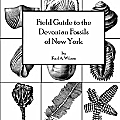- By Stephanie Meyer
- Around Town
 Print
Print  Fossil Hunters will be excited to know that PRI Publications has released the Field Guide to the Devonian Fossils of New York, by Karl A. Wilson. The book, which includes 408 species, from sponges to fish, is small and wire bound, making it ideal for taking into the gorges and ravines of New York State. The official release and book signing will take place at the Museum of the Earth Fossil ID Day, during which visitors are invited to bring fossils for identification, on Saturday, September 13th from 10:00 am until noon.
Fossil Hunters will be excited to know that PRI Publications has released the Field Guide to the Devonian Fossils of New York, by Karl A. Wilson. The book, which includes 408 species, from sponges to fish, is small and wire bound, making it ideal for taking into the gorges and ravines of New York State. The official release and book signing will take place at the Museum of the Earth Fossil ID Day, during which visitors are invited to bring fossils for identification, on Saturday, September 13th from 10:00 am until noon.The fossils in the Devonian rocks of New York have attracted the attention of serious and casual collectors for nearly 200 years. Although a large body of literature has been devoted to these fossils, most of this is not readily accessible to the non-professional fossil enthusiast. This volume, combining the best of modern paleontology with the classic illustrations of James Hall, John Clarke, Amadeus Grabau, and Winifred Goldring, fills that need. In all, 408 taxa are covered, spanning the rich taxonomic breadth of New York's Devonian strata. The author, Karl Wilson, is Professor Emeritus of Biological Sciences at Binghamton University (a biochemist by profession) and a life-long enthusiast of natural history, especially the Devonian fossils of New York.
The book is available in both the Museum of the Earth and Cayuga Nature Center gift shops, as well as Amazon.com and through the PRI website, priweb.org. Copies will be available at a special release event discount at the book signing on September 13th during the Museum of the Earth Fossil ID Day event, as well as on October 4th at the Museum’s Teacher Resource Day.
This particular field guide replaces PRI’s Guide to the Devonian Paleontology of New York by David M. Linsley, 1994, which reproduced classic illustrations from the 1850s under updated scientific names. The book was problematic because it was large and unwieldy in the field, and featured mostly pictures with little sense of scale, and very few descriptions. Some of the major groups, such as corals and sponges, were missing. For the Wilson guide, it was decided to keep the classic imagery, but to include proper descriptions, in a smaller, user-friendly sized book.
v10i34


